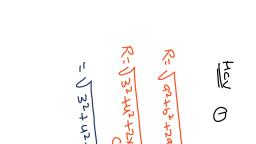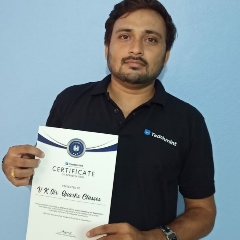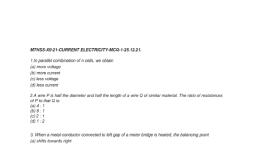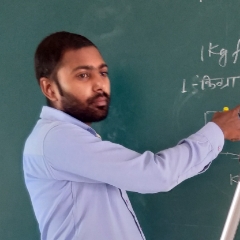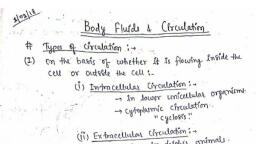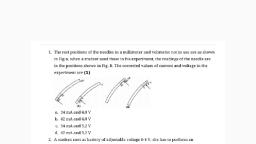Question 1 :
Kirchoffs law of junctions is also called the law of conservation of:<br/>
Question 2 :
If $10$% of the main current is to be passed through the moving coil galvanometer of resistance $99\Omega$, then the required shunt resistance will be :<br>
Question 3 :
Kirchoff's first law, i.e., $\sum i = 0$ at a junction, deals with the conservation of
Question 5 :
A moving coil type of galvanometer is based upon the principle that<br>
Question 6 :
In ballistic galvanometer, the frame on which the coil is wound is non-metallic to:
Question 7 :
Between any two points in a circuit, the sum of all .............. is the same through any pathway.<br>
Question 8 :
A metre bridge is balanced with known resistance in the right gap and a metal wire in the left gap. If the metal wire is heated the balance point<br/>
Question 9 :
Consider the following two statements:<br>(A) Kirchhoff's Junction Law follows from conservation of charge.<br>(B) Kirchhoff's Loop Law follows from conservative nature of electric field.<br>
Question 10 :
<strong>If $2\%$ of the main current is to be passed through a galvanometer of resistance $G$, then resistance of the shunt required is </strong><br/>
Question 11 :
A galvanometer with a shunt in parallel is used in series in a circuit. Then it is called<br/>
Question 12 :
A current of $10^{-7}$ ampere produces 50 division deflection in a galvanometer. Then its figure of merit will be<br>
Question 13 :
<strong>A galvanometer in series with a high resistance is called </strong><br>
Question 14 :
To measure the resistance of a device using Ohm’s law the mode of connection used is<br/>
Question 15 :
The coil of the moving coil galvanometer is wound over an aluminium frame<br/>
Question 16 :
The radial magnetic field is used in a suspended coil galvanometer to provide<br>
Question 17 :
Kirchhoff's law of junction, $\displaystyle \sum { I } =0$, is based on
Question 18 :
The current that must flow through the coil of a galvanometer so as to produce a deflection of one division on its scale is called<br>
Question 20 :
Wheatstones’s bridge cannot be used for measurement of very _______ resistances.<br/><br/>
Question 21 :
In the metre bridge experiment of resistances, the known and unknown resistances are inter-changed. The error so removed is:<br/>
Question 22 :
In a meter bridge, a standard resistor of R ohm is connected in the left gap and two wires A and B are connected one after the other in the right gap. The balancing length measured from the left is 50 cm for either of them. If the two wires are connected is series and put in the right gap, the balancing length measured from the left would be (in cm)<br/>
Question 23 :
A device used for measuring small currents due to changing magnetic field is known as:
Question 24 :
Assertion: The coil is bound over the metallic frame in moving coil galvanometer.
Reason: The metallic frame helps in making steady deflection without any oscillation.
Question 25 :
To increase the range of an ammeter, we need to connect a suitable<br/>
Question 26 :
The restoring couple in the moving coil galvanometer is due to<br/>
Question 27 :
A current of $10^{-5}$ A produces a deflection of $10^{0}$ in a moving coil galvanometer. A current of $10^{-6}$ amp in the same galvanometer produces a deflection of<br><br><br>
Question 28 :
A lamp of 6 V and 30 W is used in a laboratory but the supply is of 120 V. what will be done to make use of the lamp?<br>(1) A resistance may be used<br>(2) A resistance may be used in series with lamp.<br>(3) The resistance should be of 18 $\Omega$.
Question 29 :
A galvanometer of resistance $50\Omega $ is connected to a battery of $3 V$ along with a resistance of $2950 \Omega $ in series shown, full-scale deflection of $30$ divisions. The additional series resistance required to reduce the deflection to $20$ divisions is
Question 32 :
<span>State whether given statement is True or False<br/>The sum of all the voltage drops around a single closed loop in a circuit is zero.</span>
Question 33 :
In a moving coil galvanometer, the deflection of the coil $\theta$ is related to the electric current $i$ by the relation<br>
Question 34 :
<strong>Which of the following is likely to have the largest resistance?</strong><br>
Question 36 :
In a balanced wheat stone bridge, current in the galvanometer is zero. It remains zero when<br>$[1]$. battery emf is increased<br>$[2]$. all resistances are increased by 10 ohms<br>$[3]$. all resistances are made five times<br>$[4]$. the battery and the galvanometer are interchanged
Question 37 :
Assertion: In a simple electric circuit, positive terminal of the battery is a point of lowest potential.
Reason: The electronic current flow in a circuit is from a point of highest potential to a point of lowest potential.
Question 38 :
The primary winding of a transformer has 100 turns and its secondary winding has 200 turns. The primary is connected to an ac supply of 120 V and the current flowing in it is 10 A. The voltage and the current in the secondary are
Question 39 :
A coil of insulated wire is connected to a battery. If it is<br/>taken to a galvanometer, its pointer is deflected, because<br/>
Question 40 :
A certain current on passing through a galvanometer produces a deflection of $100$ divisions. When a shunt of one ohm is connected, the deflection reduces to $1$ division. The galvanometer resistance is
Question 41 :
The Kirchhoffs first law $(\sum i=0)$ and second law $(\sum \sum iR=\sum E)$ where the symbols have their usual meanings, are respectively based on
Question 42 :
The pole piece of the magnet used in a pivoted coil galvanometer are
Question 43 :
An ammeter is always connected in series in a circuit because<br>
Question 45 :
Assertion: Kirchhoff's junction rule can be applied to a junction of several lines or a point in a line.
Reason: When steady current is flowing, there is no accumulation of charges at any junction or at any point in a line.
Question 46 :
In a Wheatstone bridge, three resistances P, Q and R are connected in the three arms and the fourth arm is formed by two resistances $S_1$ and $S_2$ connected in parallel. The condition for the bridge to be balanced will be
Question 47 :
(A) In tangent galvanometer the circular frame is rotated until the plane of the coil is parallel to magnetic meridian<br>(B) In tangent galvanometer current through it is related to deflection of needle as
Question 48 :
Two unknown resistances are connected in two gaps of a meter-bridge. The null point is obtained at $40\ cm$ from left end. A $30\Omega$ resistance is connected in series with the smaller of the two resistances, the null point shifts by $20\ cm$ to the right end. The value of smaller resistance in $\Omega$ is
Question 49 :
The Kirchhoff's first law $(\displaystyle\sum i=0)$ and second law $\left(\displaystyle \sum iR=\displaystyle\sum E\right)$, where the symbols have their usual meanings, are respectively based on
Question 50 :
An unknown resistance $R_1$ is connected in series with a resistance of 10 ohm. This combination is connected to one gap of a metre bridge, while other gap is connected to another resistance $R_2$. The balance point is at 50 cm. Now, when the 10 ohm resistance is removed, the balance point shifts to 40 cm.Then, the value of $R_1$ is


















